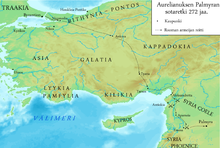Vaballathus
The unreliable Historia Augusta lists Maeonius as one of the "Thirty Tyrants" that claimed imperial power during Gallienus' reign.
This mutual recognition is testified by early coins issued by Zenobia under Vaballathus's name and acknowledging Aurelian as emperor.
Although the Palmyrene Empire was centred in Palmyra, Vaballathus and Zenobia probably spent most of their reign in Antioch,[8] Syria's administrative capital.
[15] Afterward, in 271, Septimius Zabbai, another Palmyrene general serving Zenobia, started military operations in Anatolia, and was joined by Zabdas in the spring of that year.
[18] Aurelian disappeared from Palmyrene coinage, while Zenobia and Vaballathus adopted the titles of Augusta and Augustus, respectively.
Vaballathus was named in coins "King, Emperor, Dux Romanum leader of the Romans"[19] and an open rebellion against Rome started.
[13] While the Roman general Marcus Aurelius Probus regained Egypt from Palmyra, the emperor continued his march and reached Tyana.
Other sources have implied that after shipping the defeated Zenobia and Vaballathus to Rome, Aurelian allowed both of the rebels to live, but only after they had been marched through the streets of the imperial city in accordance with Roman traditions of celebrating military victories with a triumphal procession.
[29] The city was reduced and disappeared from historical records from that time,[30] thus ending the ascendancy of Palmyra over Roman Asia Minor.



